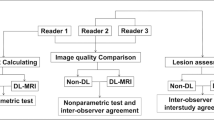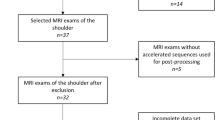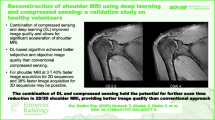Abstract
Objective
To compare the image quality and agreement among conventional and accelerated periodically rotated overlapping parallel lines with enhanced reconstruction (PROPELLER) MRI with both conventional reconstruction (CR) and deep learning–based reconstruction (DLR) methods for evaluation of shoulder.
Materials and methods
We included patients who underwent conventional (acquisition time, 8 min) and accelerated (acquisition time, 4 min and 24 s; 45% reduction) PROPELLER shoulder MRI using both CR and DLR methods between February 2021 and February 2022 on a 3 T MRI system. Quantitative evaluation was performed by calculating the signal-to-noise ratio (SNR). Two musculoskeletal radiologists compared the image quality using conventional sequence with CR as the reference standard. Interobserver agreement between image sets for evaluating shoulder was analyzed using weighted/unweighted kappa statistics.
Results
Ninety-two patients with 100 shoulder MRI scans were included. Conventional sequence with DLR had the highest SNR (P < .001), followed by accelerated sequence with DLR, conventional sequence with CR, and accelerated sequence with CR. Comparison of image quality by both readers revealed that conventional sequence with DLR (P = .003 and P < .001) and accelerated sequence with DLR (P = .016 and P < .001) had better image quality than the conventional sequence with CR. Interobserver agreement was substantial to almost perfect for detecting shoulder abnormalities (κ = 0.600–0.884). Agreement between the image sets was substantial to almost perfect (κ = 0.691–1).
Conclusion
Accelerated PROPELLER with DLR showed even better image quality than conventional PROPELLER with CR and interobserver agreement for shoulder pathologies comparable to that of conventional PROPELLER with CR, despite the shorter scan time.





Similar content being viewed by others
Data availability
The data that support the findings of this study are available on request from the corresponding author, Jisook Yi. The data are not publicly available due to (restrictions, e.g., they are containing information that could compromise the privacy of research participants).
Abbreviations
- CR:
-
Conventional reconstruction
- DLR:
-
Deep-learning based reconstruction
- SSC:
-
Subscapularis tendon
- SST-IST:
-
Supraspinatus-infraspinatus tendon
- GL:
-
Glenoid labrum
References
Subhas N, Benedick A, Obuchowski NA, Polster JM, Beltran LS, Schils J, et al. Comparison of a fast 5-minute shoulder MRI protocol with a standard shoulder MRI protocol: a multiinstitutional multireader study. AJR Am J Roentgenol. 2017;208(4):W146–54.
Lee SH, Lee YH, Song H-T, Suh J-S. Rapid acquisition of magnetic resonance imaging of the shoulder using three-dimensional fast spin echo sequence with compressed sensing. Magn Reson Imaging. 2017;42:152–7.
Del Grande F, Rashidi A, Luna R, Delcogliano M, Stern SE, Dalili D, et al. Five-minute five-sequence knee MRI using combined simultaneous multislice and parallel imaging acceleration: comparison with 10-minute parallel imaging knee MRI. Radiology. 2021;299(3):635–46.
Fritz J, Guggenberger R, Grande FD. Rapid musculoskeletal MRI in 2021: clinical application of advanced accelerated techniques. AJR Am J Roentgenol. 2021;216(3):718–33.
Kijowski R, Rosas H, Samsonov A, King K, Peters R, Liu F. Knee imaging: Rapid three-dimensional fast spin-echo using compressed sensing. J Magn Reson Imaging. 2017;45(6):1712–22.
Hou B, Li Y, Xiong Y, Morelli JN, Wang J, Liu C, et al. Comparison of CAIPIRINHA-accelerated 3D fat-saturated-SPACE MRI with 2D MRI sequences for the assessment of shoulder pathology. Eur Radiol. 2022;32(1):593–601.
Pipe JG. Motion correction with PROPELLER MRI: application to head motion and free breathing cardiac imaging. Magn Reson Med. 1999;42(5):963–9.
Fellner C, Menzel C, Fellner F, Ginthoer C, Zorger N, Schreyer A, et al. BLADE in sagittal T2-weighted MR imaging of the cervical spine. AJNR Am J Neuroradiol. 2010;31(4):674–81.
Forbes KP, Pipe JG, Karis JP, Farthing V, Heiserman JE. Brain imaging in the unsedated pediatric patient: comparison of periodically rotated overlapping parallel lines with enhanced reconstruction and single-shot fast spin-echo sequences. AJNR Am J Neuroradiol. 2003;24(5):794–8.
Ciet P, Serra G, Bertolo S, Spronk S, Ros M, Fraioli F, et al. Assessment of CF lung disease using motion corrected PROPELLER MRI: a comparison with CT. Eur Radiol. 2016;26(3):780–7.
Lane BF, Vandermeer FQ, Oz RC, Irwin EW, McMillan AB, Wong-You-Cheong JJ. Comparison of sagittal T2-weighted BLADE and fast spin-echo MRI of the female pelvis for motion artifact and lesion detection. AJR Am J Roentgenol. 2011;197(2):W307–13.
Dietrich TJ, Ulbrich EJ, Zanetti M, Fucentese SF, Pfirrmann CWA. PROPELLER technique to improve image quality of MRI of the shoulder. AJR Am J Roentgenol. 2011;197(6):W1093–100.
Nagatomo K, Yabuuchi H, Yamasaki Y, Narita H, Kumazawa S, Kojima T, et al. Efficacy of periodically rotated overlapping parallel lines with enhanced reconstruction (PROPELLER) for shoulder magnetic resonance (MR) imaging. Eur J Radiol. 2016;85(10):1735–43.
Lavdas E, Vlychou M, Zaloni E, Vassiou K, Tsagkalis A, Dailiana Z, et al. Elimination of motion and pulsation artifacts using BLADE sequences in shoulder MR imaging. Skeletal Radiol. 2015;44(11):1619–26.
Kohli A, Pilkinton DT, Xi Y, Cho G, Moore D, Mohammadi D, et al. Image quality improvement and motion degradation reduction in shoulder MR imaging: comparison of BLADE and rectilinear techniques at 3-Tesla scanning. Skeletal Radiol. 2022;51(12):2291–7.
Lebel RM. Performance characterization of a novel deep learning-based MR image reconstruction pipeline. arXiv preprint arXiv:2008.06559. 2020. https://doi.org/10.48550/arXiv.2008.06559
Ueda T, Ohno Y, Yamamoto K, Murayama K, Ikedo M, Yui M, et al. Deep Learning Reconstruction of Diffusion-weighted MRI Improves Image Quality for Prostatic Imaging. Radiology. 2022;303(2):373–81.
Recht MP, Zbontar J, Sodickson DK, Knoll F, Yakubova N, Sriam A, et al. Using deep learning to accelerate knee MRI at 3 T: results of an interchangeability study. AJR Am J Roentgenol. 2020;215(6):1421.
Kim M, Kim HS, Kim HJ, Park JE, Park SY, Kim Y, et al. Thin-slice pituitary MRI with deep learning-based reconstruction: diagnostic performance in a postoperative setting. Radiology. 2021;298(1):114–22.
Sun S, Tan ET, Mintz DN, Sahr M, Endo Y, Nguyen J, et al. Evaluation of deep learning reconstructed high-resolution 3D lumbar spine MRI. Eur Radiol. 2022;32(9):6167–77.
Yasaka K, Tanishima T, Ohtake Y, Tajima T, Akai H, Ohtomo K, et al. Deep learning reconstruction for 1.5 T cervical spine MRI: effect on interobserver agreement in the evaluation of degenerative changes. Eur Radiol 2022;32(9):6118–6125.
Hahn S, Yi J, Lee H-J, Lee Y, Lim Y-J, Bang J-Y, et al. Image quality and diagnostic performance of accelerated shoulder MRI with deep learning–based reconstruction. AJR Am J Roentgenol 2022;218(3):506–16.
Johnson PM, Tong A, Donthireddy A, Melamud K, Petrocelli R, Smereka P, et al. Deep learning reconstruction enables highly accelerated biparametric mr imaging of the prostate. J Magn Reson Imaging. 2022;56(1):184–95.
van der Velde N, Hassing HC, Bakker BJ, Wielopolski PA, Lebel RM, Janich MA, et al. Improvement of late gadolinium enhancement image quality using a deep learning-based reconstruction algorithm and its influence on myocardial scar quantification. Eur Radiol. 2021;31(6):3846–55.
Pimpalkhute VA, Page R, Kothari A, Bhurchandi KM, Kamble VM. Digital image noise estimation using DWT coefficients. IEEE Trans Image Process. 2021;30:1962–72.
Liu P, Wang Q, Peng C, Luo B, Zhang J. Combined application of isotropic three-dimensional fast spin echo (3D-FSE-Cube) with 2-point Dixon fat/water separation (FLEX) and 3D-FSE-cube in MR dacryocystography. Br J Radiol. 2019;92(1094):20180157. 1
Siegel S. Nonparametric statistics. Am Stat. 1957;11(3):13–9.
Wilcoxon F. Individual comparisons by ranking methods. Biom Bull. 1945;1:80–3.
Rayat CS. Statistical Methods in Medical Research. Singapore: Springer; 2018. p. 69–79.
Landis JR, Koch GG. The measurement of observer agreement for categorical data. Biometrics. 1977;33:159–74.
Holm S. A simple sequentially rejective multiple test procedure. Scand J Stat. 1979;65–70.
Glockner JF, Hu HH, Stanley DW, Angelos L, King K. Parallel MR imaging: a user’s guide. Radiographics. 2005;25(5):1279–97.
Reeder SB. Measurement of signal-to-noise ratio and parallel imaging. Parallel imaging in clinical MR applications. Springer; 2007, p. 49–61.
Zlatkin MB. MRI of the postoperatve shoulder. Skeletal Radiol. 2002;31(2):63–80.
Chang Y, Pipe JG, Karis JP, Gibbs WN, Zwart NR, Schar M. The effects of SENSE on PROPELLER imaging. Magn Reson Med. 2015;74(6):1598–608.
Acknowledgements
The authors specially thanks to the statistical support from Hyungwoong Kim (Clinical trial center, Inje University Haeundae Paik Hospital).
Author information
Authors and Affiliations
Corresponding author
Ethics declarations
None
Conflict of interest
Author Jisook Yi has no conflict of interest.
Author Seok Hahn has no conflict of interest.
Author Ho-Joon Lee has no conflict of interest.
Author Yedaun Lee has no conflict of interest.
Author Joonsung Lee, Xinzeng Wang, Maggie Fung are employed by GE Healthcare and have no conflict of interest.
Additional information
Publisher's note
Springer Nature remains neutral with regard to jurisdictional claims in published maps and institutional affiliations.
Supplementary information
Below is the link to the electronic supplementary material.
Rights and permissions
Springer Nature or its licensor (e.g. a society or other partner) holds exclusive rights to this article under a publishing agreement with the author(s) or other rightsholder(s); author self-archiving of the accepted manuscript version of this article is solely governed by the terms of such publishing agreement and applicable law.
About this article
Cite this article
Hahn, S., Yi, J., Lee, HJ. et al. Comparison of deep learning-based reconstruction of PROPELLER Shoulder MRI with conventional reconstruction. Skeletal Radiol 52, 1545–1555 (2023). https://doi.org/10.1007/s00256-023-04321-8
Received:
Revised:
Accepted:
Published:
Issue Date:
DOI: https://doi.org/10.1007/s00256-023-04321-8




